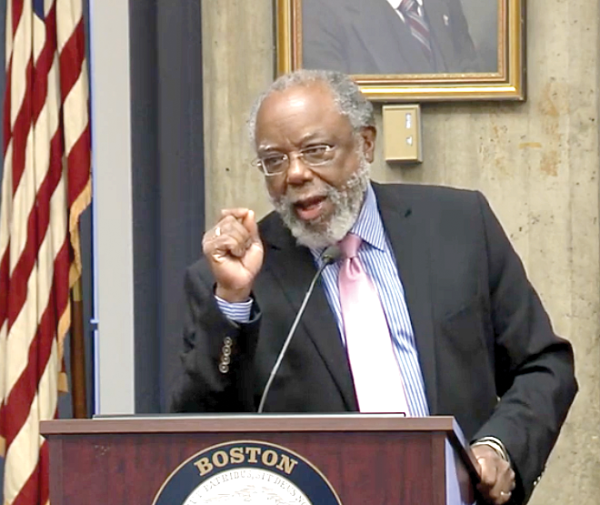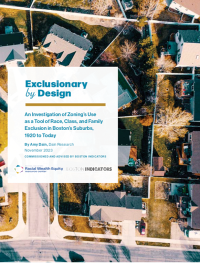November 22, 2023

Theodore ‘Ted’ Landsmark, who served as an advisor and editor of the report: “Our suburbs’ zoning has clearly worked to exclude people of color and families.” Photo courtesy YouTube

Somewhere between the migration to the suburbs in the 20th century and the tight housing market of the ongoing “Big Sort,” there was a turning point called “the Big Downzone.”
The term is used by public policy consultant Amy Dain in her new report for the Boston Indicators Project at The Boston Foundation, but her urge to decode the language of exclusionary zoning in Boston’s suburbs dates back to 2004. And her main finding is how much a 21st century housing crunch was shaped by a 20th century conflict over racial inequality.
After getting her master’s degree in public policy at the Kennedy School, Dain focused on the environmental impact of local housing regulations and land use patterns. That led to noticing, in several communities, a change in the language related to zoning around the early 1970s, just as Boston was going through an acceleration of racial change and heading toward its clash over school segregation.
At the State House Library and local libraries, Dain examined growth policy statements and plans from more than three hundred local communities, dating as far back as the 1950s. “In mid-century, many municipalities were explicit about their use of zoning for social class positioning,” she explained at an online presentation on Nov. 8. “Exclusion was not a side effect. We can cross that out. It was a purpose.”
In policy statements from predominantly white communities in the 1970s, she found tighter restrictions on development, often skewed toward more spacious single-family properties. Explicit language about race, class, or religion had given way to more nebulous terms such as “residential quality,” “social structure,” or “unique character and identity.” She also noticed the changes resulted from a complete overhaul of zoning codes, requiring adoption by a larger majority.
“I think that the zoning that I was reading in 2004, a lot had been written in the 1970s and it’s still our current day zoning,” she said. “It’s very rare that municipalities completely rewrite their zoning or trash their own zoning codes.”
As a result, some communities barred development of apartment buildings, even where they had previously been welcomed as a net gain for the tax base, with households less likely to have children in the local public schools. That prompted Dain to wonder: “Why did the whole region downzone at once?”
One possible reason was the gathering pushback against new highway construction.Others could have been the decrease in remaining land for new development or mounting concerns about the environmental impact of sprawl. Dain concluded that a different factor could have been even more decisive.
“The Big Downzone happened very suddenly and intensely at a specific point in time,” she said, “at a time of racial change, civil rights victories, and a growing call for desegregation of schools and neighborhoods.”
In June of 1974, a federal judge in Boston, W. Arthur Garrity, ordered desegregation of the city’s public schools. His choice of remedies was limited by another decision that year, by the US Supreme Court, that exempted suburban school districts from responsibility for racial inequalities in Detroit. As a result, unless racial segregation were proven within suburban schools, remedies would not be required beyond core cities such as Boston.
Less preventable was the exodus of white families from the city, often described as a response to “busing.” In his book, “Boston Against Busing,” Ronald P. Formisano applied the term, not just to the redistribution of students beginning in 1974, but to the scenario repeatedly invoked by desegregation opponents over the course of the preceding decade. Also putting a spotlight on schools were organizing efforts by Black parents and the 1965 march in Boston led by Martin Luther King, Jr., followed by passage of the state’s Racial Imbalance Act.
“Many Boston residents, including many renters, were looking to move to the suburbs, if they could find a place,” said Dain. “Zoning is a part of the school segregation story, but it does not make for good photos. It’s mostly invisible, obscured by complexity.”
Predating even the filing of the lawsuit decided by Garrity was a housing program started in parts of Boston in 1968, designed to help Black homebuyers overcome racial barriers to mortgage lending. One result of the program was accelerated population turnover in Mattapan and much of Dorchester, partly spurred by block-busting realtors and a set of lending boundaries that offered the new homebuyers a kind of inclusion—but with confinement.
According to Dain, the first zoning ordinances in Massachusetts date from the 1920s, following another period of change and upheaval. That included an increase in immigrants from southern and eastern Europe before World War I and the start of “The Great Migration,” along with the beginning of mass production for automobiles, the main vehicle for reaching the suburbs. The years during the war and soon after were marked by the country’s first “Red Scare,” the resurgence of the KKK, and more exclusionary national laws on immigration.
Some of the more recent guidelines for growth in suburban communities have expressed openness to inclusion. But, in zoning decisions on individual projects, Dain said, the prevailing effect has been a “no-growth” policy, despite passage of anti-snob zoning legislation in 1969.
In comments during the online presentation, the director of the Dukakis Center for Urban and Regional Policy at Northeastern University, Theodore C. Landsmark, argued that the “Big Downzone” had effects lasting well beyond the 1970s. Landsmark also served as advisor and editor for the report.
“Our suburbs’ zoning has clearly worked to exclude people of color and families, and in some cases, seniors, from communities, where one now finds that the greater Boston region is among the most segregated in the country,” he said.
“I think back to the number of young Black and Brown professionals who arrived in Boston at about the same time that I did,” he added, “and the vast majority of them moved away, in part because of the inability to have access to adjacent communities, and to housing and residential and educational opportunities in those communities.”
In addition to posing racial barriers, Dain said, supply restrictions in the suburbs translate more generally into higher rents and more housing insecurity in other communities.
“If you’re renting, you have to live where everybody’s renting, and there’s housing instability and there’s all the escalating prices that send you moving more often,” she said after the presentation. “And now, because of all this instability and you can’t pay rent, you’re getting evicted. Your kids aren’t getting a good education because they have to move mid-year and all their classmates are moving mid-year.”
Dain acknowledged that individual projects could still be opposed for valid reasons besides race or class. But she also noted that piecemeal zoning review prioritizes the close range and particular, with less attention to large-scale concerns over supply and demand or social polarization. She suggested that imbalance could be remedied through state or regional controls, along with more incentives for local communities.
“The local towns inevitably are going to be influenced by more conservative electoral forces within their communities and by the kinds of pushback that we’ve seen in town meetings,” she said, “and bringing towns together through state and regional action is clearly going to be essential.”
The report is part of the Boston Indicators Project research on racial wealth equity, with an eye toward policy change. In the foreword, the project’s executive director, Luc Schuster, wrote, “The narrower political boundaries are drawn, the more ‘outsiders’ are created. Primarily waiting on, or lightly incentivizing municipalities to do the right thing, has been insufficient throughout the 100 years of zoning history reviewed here.”


